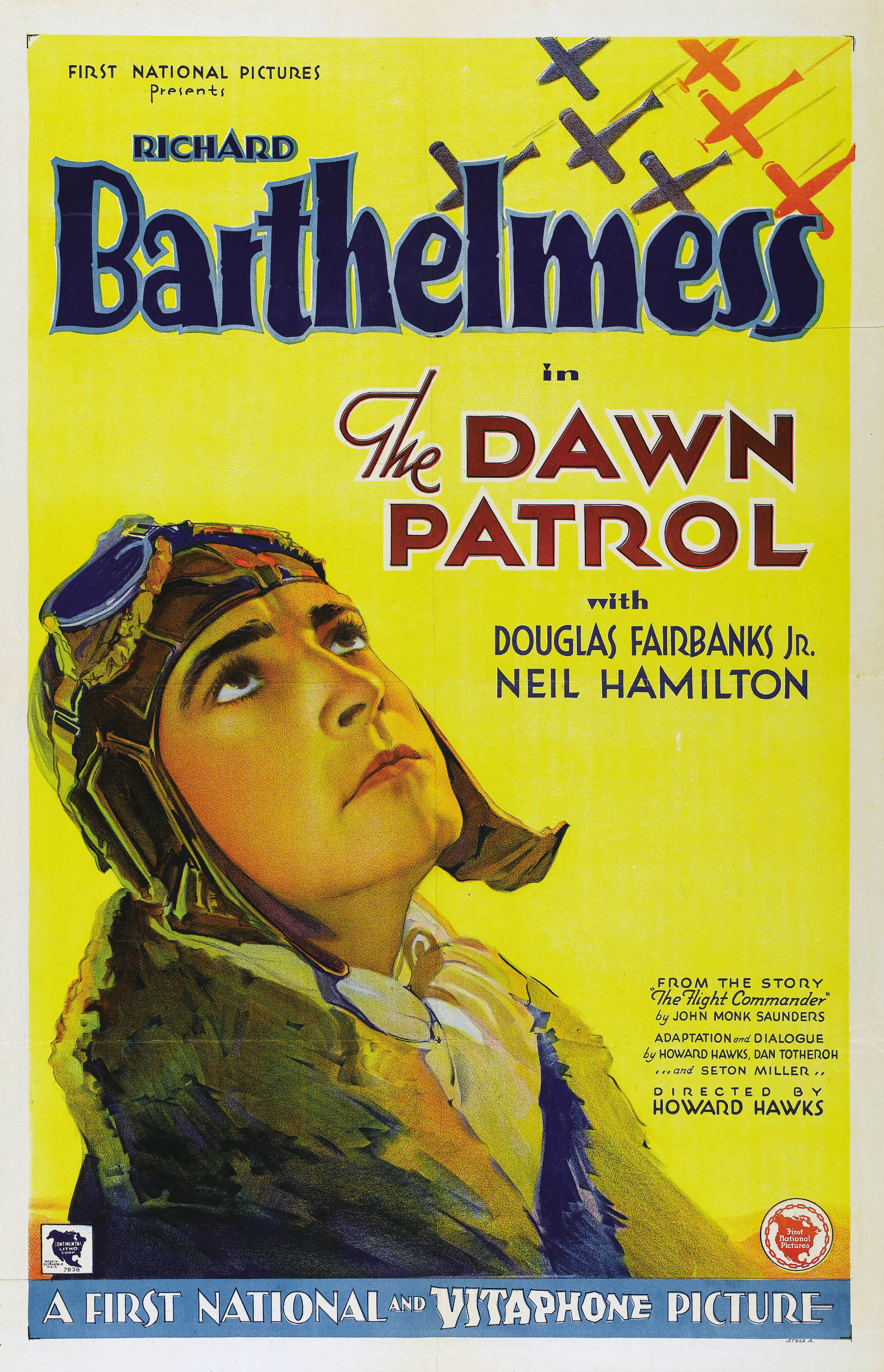All aviation combat fans are familiar with the classic “The Dawn Patrol” (1938) starring Errol Flynn, David Niven, and Basil Rathbone. But few are aware that it was actually a remake of a 1930 film. The original “Dawn Patrol” was directed by the acclaimed Howard Hawks (“Sgt. York”, “Air Force”). It was labor of love as he had joined the Army for WWI and was a flight instructor. The production had a strong connection to early air combat as the screenwriter, John Monk Saunders, had also been a flight instructor during the war. He wrote the screenplays for several aviation pics. His unfinished novel was developed into “Wings”. He won the Best Story Oscar for “The Dawn Patrol” even though there was a dispute between him and Hawks as to who originated the idea. Speaking of disputes, the movie was rushed into theaters after Howard Hughes sued over plagiarism from his “Hell’s Angels” which was in production at the same time. Warner Brothers ended up winning the suit. Hawks assembled a nice fleet of vintage, although not completely accurate, aircraft. Rebuilt Nieuport 28s were flown by the heroes and most of the Germans flew Travel Air 4000s, which were known as “Wichita Fokkers”. One of those Fokkers was flown by Hawks himself. The footage he got was so good it was used extensively in the more famous 1938 version. And when that version came out, Warner Brothers renamed the 1930 film “Flight Commander”. That’s why this movie sat in my queue so long with me not knowing what I had. So how does it compare to its more famous progeny?
“The Dawn Patrol” has one of the most influential scripts in aviation combat movie history. It is set in France in 1915 when the air war is heating up and German Fokkers are a scourge. Scott (Richard Barthelmess in the Flynn role) and Courtney (Douglas Fairbanks, Jr. in the Niven role) are chums flying for the Royal Flying Corps. Their squadron commander, Maj. Brand (Neil Hamilton, later Commissioner Gordon in the “Batman” series) is stressed out over having to send the men to their deaths. “It’s a slaughterhouse and I’m the executioner.” This movie established the trope of the commander waiting for the planes to return and counting them as they did . Brand gets no sympathy from Scott and Courtney, who see his sending new replacements to their deaths as the height of callousness. So many of them “go west” before “they can unpack”. The two buddies sure are glad Courtney’s kid brother is not there. Foreshadowing. The duo’s friendship is going to be tested when Brand has the last laugh on the morally superior Scott.
The plot is so familiar (even being used in WWI infantry combat films like “Journey’s End” and most recently in “Aces High”) that you have to remind yourself it was new in 1930. The film helped create several of the classic air combat cliches. Besides the counting of the returning planes, as seen in movies like “12 O’Clock High”, it constructs some of the standard fighter pilot tropes. Especially in WWI combat films, new pilots are very enthusiastic and clueless about being dead meat. It’s an “eat, drink, and be merry” world, with the emphasis on drink. Every mission ends with drinking (sometimes to a fallen comrade) and some singing. Names get crossed off a board. The enemy (in this case Von Richter) is a worthy foe and there is a theme of chivalry. If an enemy pilot is captured, he is feted. These may have been new in1930, but the movie is still very predictable. However, that is acceptable as the overall anti-war message is accomplished efficiently. And entertainingly.
For an early talkie, the movie holds up really well. The acting by the leads is good, although the cast pales in comparison to the 1938 version. Some of the minor characters chew the scenery a bit. The main draw are the planes and they are a real kick for aviation film enthusiasts. Although there is a surprising lack of dogfighting (about 5 minutes), the footage is amazing. It’s not in a league with “Hell’s Angels”, but Hawks was not as obsessed as Hughes was about his dogfighting. The big raid on the German air field is bravura with great stunts and effects. And you also get one of the most collateral damage scenes in movie history when a railway yard is bombed. (Speaking of cliches, according to WWI movies, fighter pilots can easily fly bombers.) I counted 6 bombs dropped and 21 explosions. Now that’s good bang for your buck!
If you’ve seen any of the children of “The Dawn Patrol”, you owe it to yourself to see the original. You won’t be surprised by anything that happens, but you will be surprised at how well the story was brought to the screen.
GRADE = B

No comments:
Post a Comment
Please fell free to comment. I would love to hear what you think and will respond.